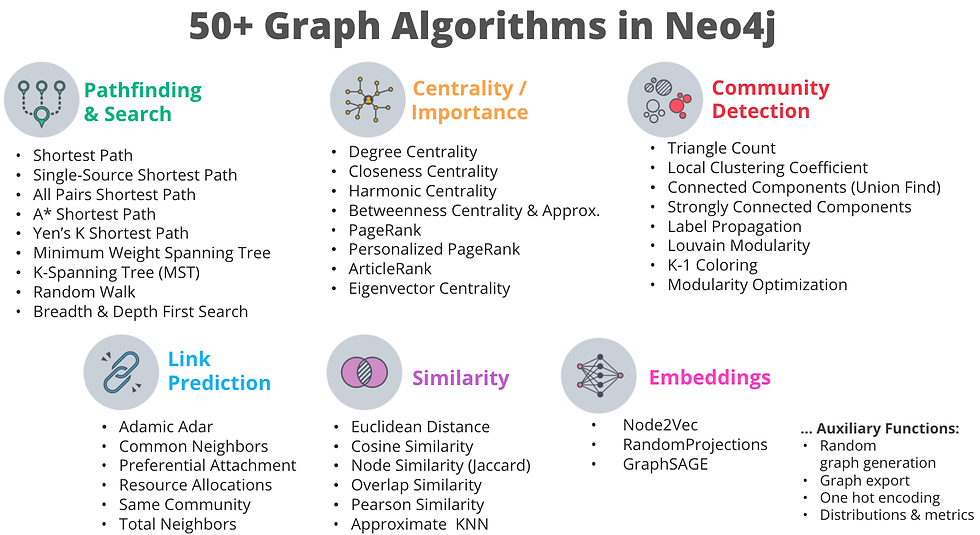Neo4j and the Ultimate Cypher Cheat Sheet for Data Scientist
- Sophie Yin
- Jan 8, 2022
- 5 min read
Updated: Jan 12, 2022

Here is the ultimate guide I have compiled for Cypher Queries that data scientists will be most interested in. This is mostly just in Cypher and does not use the Data Science Apps, please subscribe so you don't miss out on when I come out with the use of Data Science Apps.
Administrative
Login in stuff is used on Neo4j Desktop and also if you want to connect it to Python, Scala, or Java. I am also writing an article on how to use Neo4j in Scala, so please subscribe if you are interested!
:server disconnect
:help
:help cypher
//trick if you don't remember your login for external connection, //just create a new user
SHOW USERS
CREATE USER nameeee SET PASSWORD passworddd
DROP USER oldname
Creation
You can create different types of nodes or relationships together, with node label.
//Create new nodes and relationships, together or individually
CREATE (jkrowling:Person {name: "JK Rowling", born: 1965}),
(tomf:Person {name: "Tom Felton", born: 1987}),
(ruperg:Person {name: "Rupert Grint", born: 1988}),
(danielr:Person {name: "Daniel Radcliff"}),
(emmaw:Person {name: "Emma Watson", born: 1990}),
(alanr:Person {name: "Alan Rickman", born: 1947}),
(garyo:Person {name: "Gary Oldman", born: 1958}),
(hp1:Movie {title: "Philosopher's Stone", publication: 2001}),
(hp2:Movie {title: "Chamber of Secrets", publication: 2002}),
(hp3:Movie {title: "Prisoner of Azkaban", publication: 2003}),
(hp1)<-[reldan1: ACTED {role: "Harry Potter"}]-(danielr),
(emmaw)-[relem1: ACTED {role: "Hermione Granger"}]->(hp1),
(tomf)-[reltom1: ACTED {role: "Draco Malfoy"}]->(hp1),
(rupertg)-[relrup1: ACTED {role: "Ron Weasley"}]->(hp1),
(hp2)<-[reldan2: ACTED {role: "Harry Potter"}]-(danielr),
(emmaw)-[relem2: ACTED {role: "Hermione Granger"}]->(hp2),
(tomf)-[reltom2: ACTED {role: "Draco Malfoy"}]->(hp2),
(rupertg)-[relrup2: ACTED {role: "Ron Weasley"}]->(hp2),
(hp3)<-[reldan3: ACTED {role: "Harry Potter"}]-(danielr),
(emmaw)-[relem3: ACTED {role: "Hermione Granger"}]->(hp3),
(tomf)-[reltom3: ACTED {role: "Draco Malfoy"}]->(hp3),
(rupertg)-[relrup3: ACTED {role: "Ron Weasley"}]->(hp3),
(alanr)-[relal1: ACTED {role: "Severus Snape"}]->(hp1),
(alanr)-[relal2: ACTED {role: "Severus Snape"}]->(hp2),
(alanr)-[relal3: ACTED {role: "Severus Snape"}]->(hp3),
(garyo)-[relgar: ACTED {role: "Sirius Black"}]->(hp3),
(jkrowling)-[reljk1: WROTE]->(hp1),
(jkrowling)-[reljk2: WROTE]->(hp2),
(jkrowling)-[reljk3: WROTE]->(hp3)
//Create relationship between existing nodes
MATCH (p), (m)
WHERE p.name = "Gary Oldman" AND m.title = "Prisoner of Azkaban"
CREATE (p)-[:ACTED]->(m)Update
Update on existing nodes and relationships
//Update node properties
MATCH (node:Person {name: "Daniel Radcliff"})
SET node.name = "Daniel Radcliffe"
//Check and update
MATCH (node:Person)
WHERE node.name = "Daniel Radcliffe" AND node.born IS NULL
SET node.born 1989
//Update multiple node properties
MATCH (node:Person)
SET node+={name: "Daniel Radcliffe", born: 1987}
//MATCH (node:Person)
SET node = {name: "Daniel Radcliffe", born: 1989}
//Rename property
MATCH (node:Person)
WHERE node.birth IS NULL
SET node.birth = node.born
REMOVE node.bornMatch
Show and display nodes and relationships
//Single node label
MATCH (node:Person) RETURN node LIMIT 25
//Multiple node label
MATCH (node1:Person)
MATCH (node2:Movie) RETURN node1, node2 LIMIT 50
//Conditional with node properties
MATCH (node1:Person)
MATCH (node2:Movie)
WHERE node1.born > 1985
RETURN node1, node2
//Conditional with relationship label
MATCH rel =()-[r:ACTED]->()
RETURN rel LIMIT 25
//Conditional with relationship label and node properties
MATCH rel =(node1:Person)-[r:ACTED]->(node2:Movie)
WHERE node1.born > 1985
RETURN rel LIMIT 25
//Conditional with relationship label, node properties, and relationship property
MATCH rel =(node1:Person)-[r:ACTED]->(node2:Movie)
WHERE node1.born > 1985 AND r.role = "Draco Malfoy"
RETURN rel LIMIT 25
//Conditional query with newly created var to filter
MATCH (node1)-[r]->(node2)
WITH *, type(r) AS connectionType
RETURN node1.name, node2.name, connectionType
//Conditional with unwind to get subset
MATCH (node1: Person)-[:ACTED]-(node2: Movie)
WITH collect(node1) as p
UNWIND p as ll
return ll
//Unioned result with duplicates
MATCH (node:Person)
WHERE node.name = "Emma Watson"
RETURN node
UNION ALL
MATCH (node:Person)
WHERE node.name = "Rupert Grint"
RETURN node
//Unioned result without duplicates
MATCH (node:Person)
WHERE node.name = "Emma Watson"
RETURN node
UNION
MATCH (node:Person)
WHERE node.name = "Rupert Grint"
RETURN node
//alternatively you can use merge which is the combination of match //and create
MATCH (node1:Person { name: 'Daniel Radcliffe' }), (node2:Movie { name: 'Chamber of Secrets' })
MERGE (node1)-[rel: ACTED]->(node2)
RETURN rel //this first checks if the relationship exists, if it doesn't then it creates itDeletion
Deleting nodes, relationships, and properties
//Single node, must delete relationship first before deleting a //node
MATCH (node1)-[rel: ACTED]-()
WHERE node1.name = "Alan Rickman"
DELETE rel, node1
//Single relationship
MATCH (node1 {name: 'Alan Rickman'})-[rel: ACTED]->(hp1)
DELETE r
//Single node and all the connected relationships
MATCH (n {name: 'Alan Rickman'})
DETACH DELETE n
//All nodes and relationships
MATCH (n)
DETACH DELETE n
//Drop duplicates for a node to have
MATCH (node:Person)
WITH node.name AS name, COLLECT() AS branches
WHERE SIZE(branches) > 3
FOREACH ( IN branches | DETACH DELETE n )
//Check for duplicates on nodes
MATCH (p:Person)
WITH p.id as id, collect(p) AS nodes
WHERE size(nodes) > 1
RETURN [ n in nodes | n.id] AS ids, size(nodes)
ORDER BY size(nodes) DESC
LIMIT 10Constraints
Use constraints to check on your data to check if data quality and basic rules are satisfied, it will help when importing data into it, as it will check the constraints for you and enforce it
// Existence constraint on mandatory columns
CREATE CONSTRAINT ON (node: Person)
ASSET EXISTS (node.name)
// Uniqueness constraint on id
CREATE CONSTRAINT ON (node: Person)
ASSERT node.name IS UNIQUE
//Show all constraints
SHOW CONSTRAINT INFO
//Drop existence constraints
DROP CONSTRAINT ON (node: Person)
ASSERT EXISTS (node.name)
//Drop uniqueness constraint
DROP CONSTRAINT ON (node: Person)
ASSERT node.name IS UNIQUECommon Functions
Common functions of aggregation we use for SQL
//count of all nodes
MATCH (node)
RETURN COUNT(node)
//count of all relationships
MATCH ()-->()
RETURN COUNT(*)
//average of property
MATCH (node:Person)
RETURN AVG(node.born)
//you can use id, ceil, datetime, etc use CALL dbms.functions() to call on all functions available to you
//returns all unique labels
CALL db.labels()
//returns all unique relationships
CALL db.relationshipTypes()
//check how the nodes are related
CALL db.schema.visualization()General GDS call guide
The basic call for a GDS is split into a few sections:
CALL gds[.<tier>].<algorithm>.<execution-mode>[.<estimate>](
graphName: String,
configuration: Map
)
The tier is basically the functions' grade, whether they have passed the tests, but you are free to use any tier just be care of changes they make.
Tier | Description |
product-quality | Indicates that the algorithm has been tested with regards to stability and scalability. Algorithms in this tier are prefixed with gds.<algorithm> and are supported by Neo4j. |
beta | Indicates that the algorithm is a candidate for the production-quality tier. Algorithms in this tier are prefixed with gds.beta.<algorithm>. |
alpha | Indicates that the algorithm is experimental and might be changed or removed at any time. Algorithms in this tier are prefixed with gds.alpha.<algorithm>. |
The algorithm is what the data scientists and data engineers are all waiting for. Here is the list Neo4j has put out for more information on each algorithm please go to Syntax overview - Neo4j Graph Data Science

The execution mode is basically trying to target the specific uses of your purpose for running the code. Usually writing out takes a long time, so by choosing wisely on the perhaps I assume you would be able to save some time.
Execution Mode | Description |
Stream | Returns the result of the algorithm as a stream of records. |
Stats | Returns a single record of summary statistics, but does not write to the Neo4j database. |
Mutate | Writes the results of the algorithm to the in-memory graph and returns a single record of summary statistics. This mode is designed for the named graph variant, as its effects will be invisible on an anonymous graph. |
Write | Writes the results of the algorithm to the Neo4j database and returns a single record of summary statistics. |
Graph Relevant Functions
Must have already downloaded the plugins
//create the graph you are going to analyze on, you can use subsets //of the graph you are interested
CALL gds.graph.create.cypher(
'HarryPotterSeries', //graphName
'MATCH (node) RETURN id(node) as id', //nodeQuery, neo4j works on node id not
'MATCH (node)-[rel]->(node2) RETURN id(node) AS source, id(node2) AS target, rel.weight AS weight' //relationshipQuery
)
// need to label source, target, and weight
//delete a graph
CALL gds.graph.drop('HarryPotterSeries') YIELD graphName
//list of graphs with it's descriptive information
CALL gds.graph.list()
//pagerank function
CALL gds.pageRank.stream('HarryPotterSeries', {
maxIterations: 20,
dampingFactor: 0.85,
relationshipWeightProperty: 'weight'
})
YIELD nodeId, score
RETURN gds.util.asNode(nodeId).id AS id, gds.util.asNode(nodeId).name as name, score as full_pagerank
ORDER BY full_pagerank DESC
//betweenness
CALL gds.betweenness.stream(
"HarryPotterSeries"
)
YIELD nodeId, score //default yield, don't have to specify
//degree centrality
CALL gds.degree.stream(
"HarryPotterSeries"
)
//node similarity
CALL gds.nodeSimilarity.stream("HarryPotterSeries")
//louvain
CALL gds.louvain.stream('HarryPotterSeries')Bulk Load Nodes and Relationships
This will be useful to add bunch of relationships and nodes at once to build a proper graph.
LOAD CSV WITH HEADERS FROM 'https://docs.google.com/spreadsheets/d/e/2PACX-1vQxtB5bngX8UoQgqY5Ubby4DWli8ryLW0UnDv0-PPzPnvO3ChoZ3ZuHYE1Hgc8mc98TlgQ2kZIO-4_N/pub?gid=0&single=true&output=csv' AS row1
MERGE (c:Companies {companyId: row1.Id, location: row1.Location})
LOAD CSV WITH HEADERS FROM 'https://docs.google.com/spreadsheets/d/e/2PACX-1vQxtB5bngX8UoQgqY5Ubby4DWli8ryLW0UnDv0-PPzPnvO3ChoZ3ZuHYE1Hgc8mc98TlgQ2kZIO-4_N/pub?gid=736102473&single=true&output=csv' AS row2
MERGE (e:Employees {employeeId: row2.Id, email: row2.Email})
LOAD CSV WITH HEADERS FROM 'https://docs.google.com/spreadsheets/d/e/2PACX-1vQxtB5bngX8UoQgqY5Ubby4DWli8ryLW0UnDv0-PPzPnvO3ChoZ3ZuHYE1Hgc8mc98TlgQ2kZIO-4_N/pub?gid=1931026342&single=true&output=csv' AS row3
MATCH (e:Employees {employeeId: row3.employeeId})
MATCH (c:Companies {companyId: row3.Company})
MERGE (e)-[:WORKS_FOR]->(c)
RETURN *






Comments